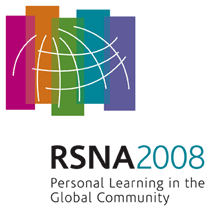
Abstract Archives of the RSNA, 2008
Christopher Wu MD, Presenter: Nothing to Disclose
Aaron David Sodickson MD, PhD, Abstract Co-Author: Nothing to Disclose
Tianxi Cai PhD, Abstract Co-Author: Nothing to Disclose
Noah Alexander Levit BS, Abstract Co-Author: Nothing to Disclose
Frank John Rybicki MD, PhD, Abstract Co-Author: Speakers Bureau, Toshiba Corporation
Advisory Board, Toshiba Corporation
Speakers Bureau, Siemens AG
Speakers Bureau, Bracco Group
Advisory Board, Bracco Group
Advisory Board, Vital Images, Inc
Stephen Ledbetter MD, Abstract Co-Author: Nothing to Disclose
To compare respiratory motion artifact between cranio-caudal vs caudo-cranial MDCT acquisition for CT pulmonary angiography (CTPA).
Retrospective review of emergency radiology CTPA exams (Siemens Somatom 64, 120 kV, CareDose reference mAs 200, effective mAs range 126-343) acquired between 5/07 and 1/08 identified two groups, each 50 consecutive patients: 1) caudo-cranial acquisition (39 F, mean age 52.3 yrs, pitch 0.75, mean scan duration 9.1 ± 1.1 sec ); 2) cranio-caudal acquisition (30 F, mean age 48.5 yrs, pitch 1, mean scan duration 7.1 ± 0.9 sec). Two readers blinded to clinical and protocol data reviewed randomized, coronal reformatted images in lung windows using PACS and scored severity of respiratory motion artifact in the upper, middle, and lower lung zones on a 3-point scale (0=no artifact, 1=mild, 2=moderate, 3=severe). Caudo-cranial vs cranio-caudal differences in artifact severity were assessed by determining whether the observed C-statistic (concordance statistic) was significantly different from the null value of 0.5, and p-values obtained with the permutation method.
For the upper, middle, and lower lung zones, the caudo-cranial vs cranio-caudal mean artifact scores were 0.24 vs 0.06 (C=0.55, p=.05), 0.40 vs 0.28 (C=0.52, p=0.60), and 0.52 vs 0.39 (C=0.52, p=0.65), respectively. Comparison of the most severe artifact score per patient resulted in a nonsignificant trend towards better quality from cranio-caudal scanning, with mean artifact scores 0.69 vs 0.50 (C=0.54, p=0.37). There was 83% perfect agreement between graders, and 99.3% agreement within 1 grade. The weighted kappa= 0.78 with squared weightings.
Cranio-caudal CTPA acquisition with a slight decrease in scan time had less respiratory motion artifact than caudo-cranial scanning in the upper lung zone and performed at least as well in the middle and lower lung zones, and on an overall patient by patient basis.
A cranio-caudal direction for 64-slice CT pulmonary angiography acquisition is a viable alternative compared to the widespread practice of caudo-cranial scanning.
Wu, C,
Sodickson, A,
Cai, T,
Levit, N,
Rybicki, F,
Ledbetter, S,
Heads or Tails? Comparison of Respiratory Motion Artifact in Cranio-caudal versus Caudo-cranial 64-slice CT Pulmonary Angiography. Radiological Society of North America 2008 Scientific Assembly and Annual Meeting, February 18 - February 20, 2008 ,Chicago IL.
http://archive.rsna.org/2008/6013141.html

